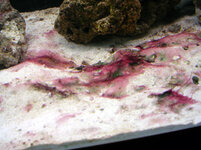- Joined
- Dec 22, 2004
- Messages
- 1,713
Nancy said:Are we sure this is coralline algae? - I've never had any form on the sand, although it will cover almost anything else: rocks, shells, snail shells, glass, etc.
Nancy
I'm starting to wonder this, too. The stuff that's on the sand cements the grains together, which is presumably consistent with what a coralline algae would do. In a few spots where its particularly thick--especially on one of my pieces of live rock--it has pink wavy filaments coming off like you usually see with green algae. Its hard for me to imagine something calcareous waving with the current.
My test kit is a brand new FasTest kit from Aquarium Systems. The chemicals come in individual foil pouches. I still have my old Tetra kit that just expired. I'm using both for redundancy.
My light is on for 12 hours. I'm sure that's a culprit, and tonight I will cut the timer down to 8. I don't expect that will be an end-all? I was going to make a run to the LFS tonight. I'm planning on getting a brittle star and an army of crabs and snails. Its a little easier for me to spend for them now since I know it'll be at least another month before they become meals
Dan

